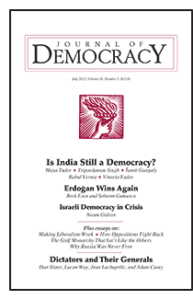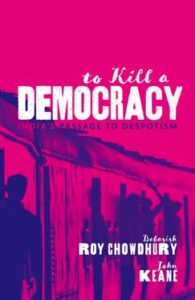Today’s India is an “illiberal democracy”. Freedom House, the US think-tank, puts it at the same level as Hungary. But it rates the components differently: political rights, notably electoral politics, are healthier in India than in Hungary, but civil rights are weaker, The FT’s Martin Wolf asserts. Worse, the latter have deteriorated substantially under BJP rule since 2014. India’s ratings on democracy are still far higher than those of, say, Bangladesh, Pakistan or Turkey. But it is not a “liberal democracy”: Freedom House simply labels the country “partly free”.
But matters are rather more complicated, according to Ashoka University’s Rahul Verma.
 “The BJP-dominant party system is marked by a paradox. Indian democracy is expanding and deepening on some counts and shrinking on others,” he wrote in “The Exaggerated Death of Indian Democracy,” an article for the recent Journal of Democracy.
“The BJP-dominant party system is marked by a paradox. Indian democracy is expanding and deepening on some counts and shrinking on others,” he wrote in “The Exaggerated Death of Indian Democracy,” an article for the recent Journal of Democracy.
In what sense is it widening or deepening? he asks on Democracy Paradox:
Basically, the turnout rates in India have been increasing. India does not have a compulsory voting system. Turnout rates, which were somewhere around 58-59% in the early 2000s, in 2014, when BJP and Modi came to power for the first time, actually jumped by six percentage points. In 2019, the turnout again jumped by two and a half percentage points. ……The deepening is happening as representation in the cabinet has widened. Now you have many more segments that are getting ministries and ministry representatives.
“While Indian democracy is widening on the electoral front, we’re also shrinking, Verma adds. “Most of our parties have become dynasties. … India has some 36 parties in the parliament and some 30 of them are controlled by single families.”
 India is a complex federation of regional identities, many of which consider themselves distinct from Hindi-speaking north India, the power base of Mr. Modi’s party, adds Debasish Roy Chowdhury (@Planet_Deb), a Hong Kong-based Indian journalist and the author, with John Keane, of “To Kill a Democracy: India’s Passage to Despotism.”
India is a complex federation of regional identities, many of which consider themselves distinct from Hindi-speaking north India, the power base of Mr. Modi’s party, adds Debasish Roy Chowdhury (@Planet_Deb), a Hong Kong-based Indian journalist and the author, with John Keane, of “To Kill a Democracy: India’s Passage to Despotism.”
This federal structure is held together by delicate bonds of social and political accommodation, he writes for The New York Times. But they are fraying fast under Mr. Modi, who has no appetite for either, shrinking the space for nonviolent political contestation. Some regional political parties see the Bharatiya Janata Party’s centralizing and homogenizing Hindu-first thrust as a cultural imposition from outside and are assailing it with the same divisive us-versus-them vocabulary.
India’s Democracy: Resilient or Endangered? (above) CFR panelists discuss the health of Indian democracy, including the rise and popularity of Prime Minister Narendra Modi and his ruling Bharatiya Janata Party, perceived democratic backsliding, and potential outcomes of upcoming state and national elections. Pratap Bhanu Mehta, Lisa Mitchell, Ashutosh Varshney. Bobby Ghosh.







